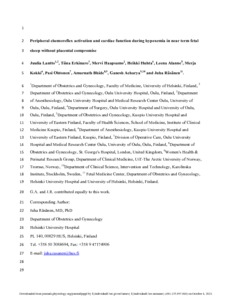Lantto, J; Erkinaro, T; Haapsamo, M; Huhta, H; Alanne, L; Kokki, M; Ohtonen, P; Bhide, A; Acharya, G; Räsänen, J
(2021)
Peripheral chemoreflex activation and cardiac function during hypoxemia in near term fetal sheep without placental compromise.
J Appl Physiol (1985), 131 (5).
pp. 1486-1495.
ISSN 1522-1601
https://doi.org/10.1152/japplphysiol.01111.2020
SGUL Authors: Bhide, Amarnath
![[img]](https://openaccess.sgul.ac.uk/113719/1.hassmallThumbnailVersion/japplphysiol.01111.2020.pdf)  Preview |
|
PDF
Accepted Version
Available under License ["licenses_description_publisher" not defined].
Download (1MB)
| Preview
|
Abstract
A drop in arterial oxygen content activates fetal chemoreflex including an increase in sympathetic activity leading to peripheral vasoconstriction and redistribution of blood flow to protect the brain, myocardium, and adrenal glands. By using a chronically instrumented fetal sheep model with intact placental circulation at near-term gestation, we investigated the relationship between peripheral chemoreflex activation induced by hypoxemia and central hemodynamics. 17 Åland landrace sheep fetuses at 115-128/145 gestational days were instrumented. Carotid artery was catheterised in 10 fetuses and descending aorta in 7 fetuses. After a 4-day recovery, baseline measurements of fetal arterial blood pressures, blood gas values, and fetal cardiovascular hemodynamics by pulsed Doppler ultrasonography were obtained under isoflurane-anesthesia. Comparable data to baseline was collected 10 (acute hypoxemia) and 60 minutes (prolonged hypoxemia) after maternal hypo-oxygenation to saturation level of 70-80% was achieved. During prolonged hypoxemia, pH and base excess (BE) were lower, and lactate levels higher in the descending aorta than in the carotid artery. During hypoxemia mean arterial blood pressure (MAP) in the descending aorta increased, while in the carotid artery MAP decreased. In addition, right pulmonary artery pulsatility index values increased, and the diastolic component in the aortic isthmus blood flow velocity waveform became more retrograde. Both fetal ventricular cardiac outputs were maintained even during prolonged hypoxemia when significant fetal metabolic acidemia developed. Fetal chemoreflex activation induced by hypoxemia decreased the perfusion pressure in the cerebral circulation. Fetal weight-indexed LVCO or AoI Net Flow-ratio did not correlate with a drop in carotid artery blood pressure.
Statistics
Item downloaded times since 04 Oct 2021.
Actions (login required)
 |
Edit Item |



